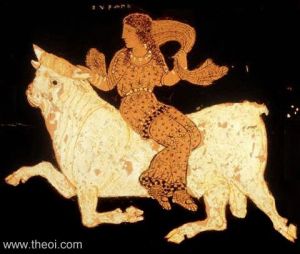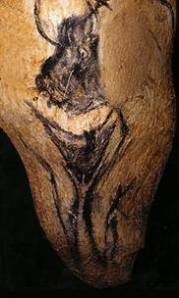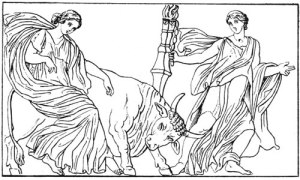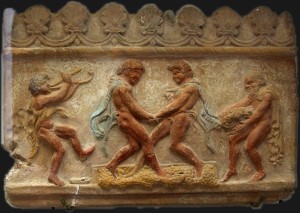
“Cultivated hemp. Cannabis (some call it Cannabion, some Schoinstrophon, some Asterion) is a plant of much use in this life for the twisting of very strong ropes. It bears leaves like to the Ash, of a bad scent, long stalks, empty, a round seed, which being eaten of much doth quench geniture, but being juiced when green is good for pain of the ears.” (Russo, E.B., MD. Cannabis and Cannabinoids: Pharmacology, Toxicology, and Therapeutic Potential)
“Pausanias continues that above the Argive Heraion flowed the river Asterion, on whose banks grew the asterion plant. The vines and leaves were woven into garlands for the statue of Hera, and the plant was made an offering to Her. Asterion was one of the ancient names for cannabis, according to the first century C.E. Greek physician named Dioscurides.” (Rigoglioso, M. The Cult of Divine Birth in Ancient Greece)
Note: the following blog post in no way reflects the teachings of the Minoan Brotherhood. It is a result of my own independent research into entheogens. NO secret teachings of the Brotherhood are held within this post.
Cannabis
Cannabis has been a psychotropic drug, otherwise known as an entheogen, since ancient times. The origin of the plant is thought to have come from Central Asia (Rudgley, R. The Lost Civilizations of the Stone Age). Its use for twine is well-known, but braziers were also discovered as far west as Romania showing evidence that the seeds were burnt for ritual purposes (and I suspect the use of cannabis may have lead to big munchies which nearly killed of the Mammoths, but just my morbid speculation). These discoveries date back to the Neolithic Era. Cannabis, along with opium, were venerated in places like Minoan Crete for their properties as mind-altering substances which opened up the portals to the spirit realm. It’s a well-known fact that many spirit walkers in indigenous societies use entheogens in order to connect with the spirit realm. Central Asia, as the ancient home of cannabis, is also conjectured to be the source of Pythagoras’ teacher Abaris (Kingsley, P. A Story Waiting to Pierce You). It wouldn’t be too much of a leap in logic to suggest that wherever a spirit-walker went, his psychotropic drugs went with them.
Connecting to the Spirits
This fact makes the illegal status of marijuana even more of a travesty, since it is forbidding us from engaging with the Gods in ways our ancestors would have known. Many realms, I believe, remain untapped due to the non-use of this potent drug, and it has also diluted the essential power of the Craft (in my opinion). To be a spirit walker, an iatromantis, a shaman, or what-have-you, is to have an alliance with the realms of the plant and animal spirits. It means to remember the time of the Sacred Ancestors and join in the Sun Dance of the Labyrinth. It means to open ourselves up to the spirits themselves and use their connection as a authentication of our power. Without that connection, a spirit walker is nothing. Although the use of drugs is not necessary, it is also not forbidden. I think the Mysteries, missing this ingredient, are robbed in some way of their true essence. These plants had a meaning that was more than the average street user or the “War on Drugs” politician could ever imagine. They were the lifeline our ancestors relied on for a purpose. Opium was sacred to the Goddess Rhea for a reason. Cannabis was labeled Asterion for a reason.

The White Bull and the Western Cow
As I wrote in another post, the public name of the God in the Minoan Brotherhood is Asterion. The mythology we have available states that Asterion was the name of two sacred kings in Minoan Crete: the first was a Cretan King who reared the children of Zeus and Europa. Europa was a Phoenician princess (hinting at the cultural relationship between the Minoans and the Phoenicians), kidnapped by Zeus in the form of a white bull. The etymology of Europa means “wide-eyed,” and hints that she was possibly a Cow Goddess. The abduction story of Europa is very similar to the kidnapping of Kore by Hades:
“Zeus saw Europa the daughter of Phoenix gathering flowers in a meadow with some nymphs and fell in love with her. So he came down and changed himself into a bull and breathed from his mouth a crocus.18 In this way he deceived Europa, carried her off and crossed the sea to Crete where he had intercourse with her. Then in this condition he made her live with Asterion the king of the Cretans. There she conceived and bore three sons, Minos, Sarpedon and Rhadamanthys. The tale is in Hesiod and Bacchylides.” (The Catalogues of Women by Hesiod).
All three sons were raised by Asterion, who wed Europa. After their marriage, Zeus transformed the White Bull into the constellation Taurus. Two of the sons, Minos and Rhadamanthys, became Judges of the Underworld. Sarpedon became a long-lived king (some say he died in the Trojan War, and Philostratus mentions that he, too, became Judge in the Underworld with his brothers). This is quite the story, and holds a lot of interest to me because of the early relationship, as I previously pointed out, about the kidnapping of the Maiden to become a Queen of a rich land.

The Star of the Labyrinth
The second Asterion is the Minotaur of the Labyrinth. Asterion was the Son of Poseidon (the Zeus of the Sea) and Pasiphae, daughter of the Sun God, sister of the sorceress Kirke, and wife of Minos (son of Zeus). Pasiphae was considered to be a Goddess in Her own right. Plutarch mentions:
“Now there was a temple and much respected oracle of Pasiphae at Thalamae.” (Plutarch on Sparta, p. 60).
Pasiphae possessed the ability of Witchcraft, which was to say she was a skilled pharmakos. I personally would LOVE to know how she had her husband ejaculate scorpions, millipedes and snakes into women she hated. Talk about some jacked up shit! That makes for a great anime!
Anyway, Pasiphae and Poseidon’s child was at the center of the Labyrinth. For now we’re ignoring the Greek telling, because it was full of political claptrap that made the Athenians look good and the Minoans very evil. Theseus, the hero, was the legendary founder of Athens (and Athenian democracy which subjugated women as chattels and property). What a piece of shit. Ignoring the political veneer, the Minotaur is shown in the Attic Kylix just like the classic Mother-Child motif found with Aset (Isis) and Heru (Horus), Parvarti and Ganesha, and Mary with Jesus.
R.F. Willetts speculates that the Labyrinth design was based on an ancient sun dance (Ancient Crete: From Early Times Until the Roman Occupation). The ancient mimetic dance was probably used to honor the Sun Bull, the Cretan Zeus, who was represented in the person of the Minoan King. The journey into the Labyrinth and from it was probably a rite of Initiation, whereby the person was led by the Priestess (Ariadne, the Spider Weaver who used the scarlet cord to lead them to the center). At the very heart, the initiate became the Man-Bull: the union of Divinity and Mortality.
Reefer Madness!
Cannabis was identified as being called Asterion, the gift of Poseidon. His mother was a pharmakoi Goddess, Pasiphae. The ritual use of cannabis was the catalyst of Enlightenment (or, as I call it, Gnosis). The prototype for Dionysus from Crete, then, is the jewel Cannabis: the Son of the pre-Olympian Poseidon who is the Sacred Bull. That’s right peoples: reefer madness of Dionysus! Pipe it up, inhale, and enjoy the effects. In fact, cannabis enjoys and interesting piece of warning which the United States slapped on it much like the Romans did on the Bacchic revels in 186 BCE:
“Marihuana is that drug – a violent narcotic – an unspeakable scourge – The Real Public Enemy Number 1! It’s first effect is sudden, violent, uncontrollable laughter; then come dangerous hallucinations – space expands – time slows down, almost stands still…fixed ideas come next, conjuring up monstrous extravagances – followed by emotional disturbances, the total inability to direct thoughts, the loss of all power to resist physical emotions…leading finally to acts of shocking violence…ending often in incurable insanity.”
Eirene kai Hugieia!
(Peace and Health!)
~Oracle~
Sources:
Hunter, R. (Ed.)(2008). The Hesiodic Catalogue of Women: Constructions and Reconstructions.
Kingsley, P. (2010). A Story Waiting to Pierce You: Mongolia, Tibet, and the Destiny of the Western World.
Rigoglioso, M. (2009). The Cult of Divine Birth in Ancient Greece.
Rudgely, R. (1999). The Lost Civilizations of the Stone Age.
Russo, E.B., MD. (2002). Cannabis and Cannabinoids: Pharmacology, Toxicology, and Therapeutic Potential.
Talbert, R.J.A. (Transl.) (1988). Plutarch on Sparta.
Willetts, R.F. (1965). Ancient Crete: From Early Times Until the Roman Occupation.





